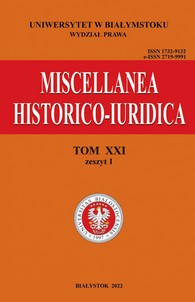Władza królewska ze szczególnym uwzględnieniem uprawnień prawodawczych monarchy w Królestwie Danii epoki Waldemarów. Analiza na podstawie wybranych źródeł prawa z I poł. XIII w.
Royal Power with Particular Reference to the Legislative Powers of the Monarch in the Kingdom of Denmark of the Valdemar Era. The Analysis on the Basis of Chosen Sources of Law from the First Half of the 13th Century
Author(s): Andrzej Gaca, Hubert BąkSubject(s): History of Law, 13th to 14th Centuries
Published by: Wydawnictwo Uniwersytetu w Białymstoku
Keywords: royal power; legislative power; royal legislation; the Law of Jutland; prologue to the Law of Jutland; Valdemar Era;
Summary/Abstract: The period in Danish history which began with the accession of power by Valdemar I in 1157 and ended with the death of his youngest son, Valdemar II (1241), known by posterity as the Victorious or the Lawgiver, is considered in Danish historiography as a time of significant social, political and legal changes. It is sometimes even named as the golden period of the Kingdom’s history in the Middle Ages, the so-called “Valdemar Era”. After years of internal struggles for power, real feudal fragmentation, and recognition of the emperor’s fief sovereignty, the nearly 100-year reign of Valdemar I and his two sons brought a re-consolidation of the state that included an expansion of royal authority, including the legislative powers of the rulers. This process was accompanied by cooperation between the state and the Church, whose support and approval led not only to a series of territorial conquests, the ordering of the treasury and the administrative apparatus, but also to the writing of the laws in force. It should be noted that beginning with the issuance of King Canute’s Law of Murder in 1200, the monarch begins to act as an independent legislator, which, given the customary legislative powers vested in the district councils (ting), is a significant innovation. As a culmination of the increased legislative activity of the rulers of the „Valdemar Era”, in 1241, the first Danish law on the Jutland district, Jyske Lov, was „given” with royal sanction. This law is preceded by a prologue, which can be regarded as a sui generis fundamental statute indicating, among other things, the scope of the monarch’s rights and duties, including the king’s legislative powers. The analysis of selected royal decrees from the first half of the 13th century, including especially the prologue to Jyske Lov, will allow, taking into account the political background, to present the scope of royal authority of the rulers of the ≪Valdemar Era≫”, with particular emphasis on the monarch’s legislative powers.
Journal: Miscellanea Historico-Iuridica
- Issue Year: 21/2022
- Issue No: 1
- Page Range: 473-497
- Page Count: 25
- Language: Polish

